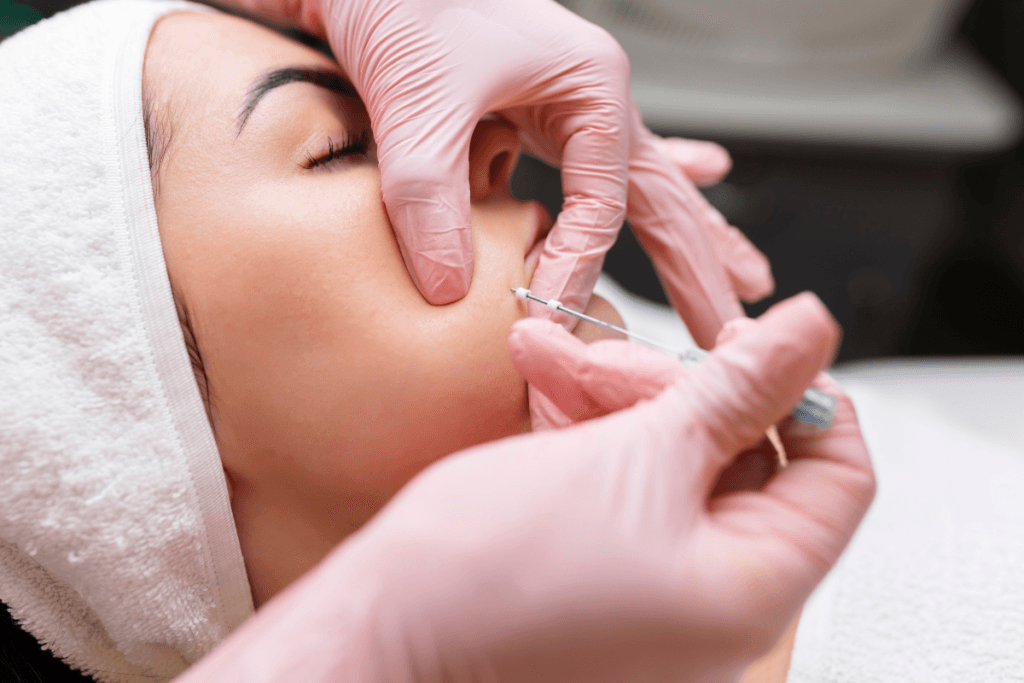Thread-based rejuvenation techniques have gained remarkable popularity in aesthetic medicine as a minimally invasive solution for skin lifting and tightening. Among these, polydioxanone (PDO) threads have become one of the most commonly used due to their safety profile, biodegradability, and ability to stimulate collagen production.
According to recent market analyses, global demand for thread lifts has risen steadily, reflecting a shift toward non-surgical alternatives to facelifts. For medical practitioners, understanding what PDO threads are, their mechanisms of action, and clinical considerations is essential for safe and effective practice.
Understanding PDO Threads
PDO threads are absorbable sutures made of polydioxanone, a biocompatible synthetic polymer widely used in cardiovascular and orthopedic surgeries. When strategically placed into the dermis or subdermal layers, these threads provide structural support, mechanical lifting, and a biological response that promotes neocollagenesis.
The concept of PDO thread lift involves creating an immediate lifting effect, followed by long-term skin rejuvenation through the stimulation of collagen. PDO threads eventually dissolve within the tissue, leaving behind strengthened collagen networks that support firmer, more resilient skin.
What Are PDO Threads Made Of?
Polydioxanone (PDO) is a colorless, crystalline polymer commonly used in absorbable surgical sutures. It is broken down by hydrolysis in the body, typically over a period of 6 to 9 months. Its long-standing use in medicine provides a proven safety record, making PDO threads a reliable choice for aesthetic procedures.
For practitioners, it is essential to note that PDO is non-allergenic and does not trigger significant immune rejection. Its degradation products, primarily carbon dioxide and water, are naturally metabolized and excreted from the body.
Clinical Types of PDO Threads
There are several categories of threads, each with unique applications and benefits:
- Barbed or Cog PDO Threads: Provide a mechanical lifting effect by anchoring into tissue.
- Mono PDO Threads (Smooth Threads): Best for skin tightening and collagen stimulation without intense lifting. PDO smooth threads are often used to treat fine lines and delicate areas, such as the periorbital and perioral regions.
- Screw or Twisted PDO Threads: Offer added volume by creating a scaffold effect within the dermis.
Choosing the right type depends on the patient’s concerns, skin laxity, and desired outcomes.
Examples of PDO Thread Products for Clinical Use
Practitioners have access to a wide range of PDO threads, each designed for specific lifting and rejuvenation needs. Here are some notable products frequently used in aesthetic practice:
Intraline PDO Thread M2738 Mono
These are mono threads designed for subtle tightening and collagen stimulation. They are ideal for fine lines, delicate areas such as the periorbital region, and overall skin texture improvement.
Mono 29G/38 (20 pcs)
A versatile option for practitioners performing facial rejuvenation with smooth threads. These provide mild tightening effects and are often used in combination with other modalities for enhanced skin quality.
Intraline PDO Thread T2650 Double
This thread features a double-strand structure, providing greater lifting power compared to standard mono threads. It is suitable for areas requiring more substantial support, such as the jawline or midface.
Mint PDO Threads
Mint PDO threads are known for their strong lifting capacity and advanced barbed design. They are widely used for contouring the jawline, lifting sagging cheeks, and improving midface definition with minimally invasive techniques.
Mechanism of Action: How Do PDO Threads Work?
The effectiveness of PDO threads relies on both immediate mechanical support and delayed biological stimulation:
- Mechanical Lift: Barbed threads reposition sagging tissues, providing instant elevation of the midface, jawline, or brow.
- Collagen Induction: Thread placement triggers a localized inflammatory response, stimulating fibroblasts to produce new collagen, elastin, and hyaluronic acid.
- Neovascularization: Increased blood supply improves skin quality and hydration over time.
- Gradual Absorption: As the PDO material is hydrolyzed, the new collagen structure maintains skin firmness even after the threads dissolve.
This dual action makes PDO threads an appealing choice for practitioners seeking long-lasting but non-permanent results.
Threading with Face PDO: Clinical Indications
Face PDO threading is most commonly performed for:
- Midface sagging and nasolabial folds
- Jawline definition and jowl correction
- Eyebrow lifting
- Neck and submental tightening
- Fine wrinkles around the lips and eyes
Beyond facial use, PDO threads can also be applied in body areas with mild laxity, including the abdomen, knees, and upper arms. Patient selection is critical; those with mild to moderate laxity tend to achieve the best outcomes.
PDO Threads Before and After: Patient Outcomes
For medical practitioners, visual outcome data is central to clinical decision-making. PDO threads, as shown in before-and-after photos, consistently demonstrate improved skin tightening, enhanced contouring, and a reduction in wrinkles. Results are immediate due to mechanical lifting, but continue to improve over 3–6 months as collagen matures.
However, outcomes depend heavily on technique, the number of threads used, and anatomical assessment. Patients with advanced skin laxity may require surgical options instead; therefore, thorough pre-treatment counseling is crucial.
How Long Do PDO Threads Last?
On average, PDO threads dissolve in 6 to 9 months. The lifting and rejuvenating effects, however, can last 12 to 18 months due to ongoing stimulation of collagen. The duration of results depends on the thread type, insertion technique, and patient-specific factors, such as age, lifestyle, and skin quality.
For practitioners, setting realistic expectations is vital. Patients should be informed that results are temporary, and repeat sessions may be necessary to maintain improvements.
The Cost of PDO Threads: Patient Considerations
The PDO threads cost varies widely depending on thread type, number used, practitioner expertise, and geographic region. In clinical practice, fees may range from a few hundred to several thousand dollars. Transparency in pricing and communicating the need for maintenance treatments can help manage patient expectations.
Practitioners should emphasize value rather than cost alone, highlighting that PDO threads offer a bridge between non-invasive fillers and surgical lifting procedures.
Benefits of PDO Threads for Patients
The growing popularity of PDO threads reflects their advantages:
- Minimally invasive with local anesthesia
- Immediate lifting effect with gradual collagen remodeling
- Short recovery time compared to surgical lifts
- High safety profile with minimal scarring
- Can be combined with other treatments (fillers, PRP, laser) for synergistic results
For patients hesitant about surgery, PDO threads offer an attractive alternative.
Risks, Complications, and Safety Profile
Although generally safe, PDO threading carries some risks. Complications may include:
- Bruising and swelling
- Thread migration or visibility under thin skin
- Asymmetry or overcorrection
- Rarely, infection or nerve injury
Proper training, sterile technique, and correct patient selection minimize the risk of complications. Informed consent should cover both expected outcomes and potential risks.
Training and Clinical Skills for Practitioners
Successful PDO thread lifting requires anatomical precision and advanced technique. Practitioners must understand facial vectors, depth of insertion, and tension adjustments to perform facial rejuvenation procedures effectively. Continuing medical education and hands-on workshops are strongly recommended before offering this service.
Developing proficiency not only ensures patient safety but also improves outcomes and builds trust in clinical practice.
Future Directions in Thread-Based Aesthetics
The field of thread lifting continues to evolve, with research exploring hybrid threads that combine PDO with polylactic acid (PLA) or polycaprolactone (PCL) for longer-lasting effects. Innovations in thread design, such as molded cogs and barbs, may improve lifting capacity and durability.
As demand for non-surgical facial rejuvenation continues to grow, PDO threads are likely to remain a cornerstone of aesthetic practice, offering both versatility and patient satisfaction.
For those seeking minimally invasive facial rejuvenation, safety and effectiveness are key. You can find high-quality PDO threads, including options such as Intraline Mono, Double, and Mint PDO Threads, designed for precise lifting, tightening, and contouring. Explore our PDO Threads collection page to learn more about each type and choose the right solution for your practice with confidence and convenience.
Conclusion
For medical practitioners, understanding what PDO threads are is key to offering patients safe, effective, and minimally invasive rejuvenation options. By combining mechanical lifting with collagen stimulation, PDO threads bridge the gap between injectables and surgical facelifts, offering a more comprehensive approach to facial rejuvenation. With proper training, patient selection, and realistic counseling, PDO threads can deliver outcomes that align with modern patient expectations for natural, subtle, and non-surgical results.
Frequently Asked Questions (FAQs)
Can PDO threads be combined with other aesthetic treatments?
Yes, PDO threads can be safely combined with fillers, botulinum toxin, PRP, and energy-based devices. Combination therapy often enhances results by addressing both volume loss and skin laxity. Proper timing and treatment sequencing are essential for safety.
What patient characteristics predict the best results?
Patients with mild to moderate skin laxity, good skin quality, and realistic expectations tend to respond best. Younger patients often see more durable results due to higher collagen activity. Advanced sagging may be better addressed with surgery.
How soon can patients return to their normal activities?
Most patients return to work and daily life within 24–48 hours. Strenuous activity, facial massage, and dental work should be avoided for about two weeks. Following aftercare instructions significantly reduces the risk of complications.
What complications should practitioners monitor for?
Common issues include bruising, swelling, and temporary discomfort. Less common complications may involve thread extrusion, dimpling, or asymmetry. Careful placement technique and follow-up visits help manage these risks early.
Are PDO threads suitable for darker skin tones?
Yes, PDO threads are considered safe for all skin types and tones. Unlike specific lasers or peels, they do not carry a risk of post-inflammatory hyperpigmentation. This makes them a versatile option across diverse patient populations.







